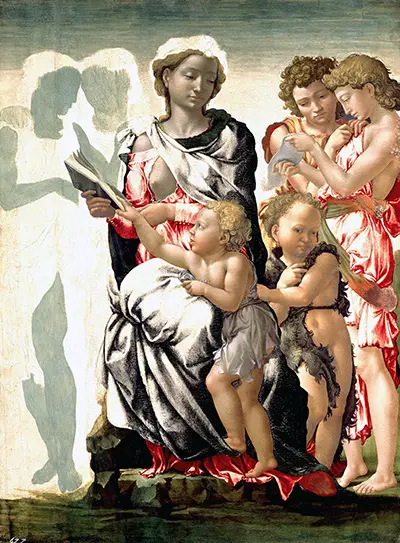In the portion of the work which was produced, two angels are seen contemplating a book held open by the Virgin Mary. A specific passage in this book is being indicated by Jesus Christ, although it is not known for certain what the passage is about. It is usually suggested that it may allude to Christ's future, in particular his suffering and death. The painting, which measures around 105 cm by 77 cm and is in tempera on wood, acquired the name "Manchester Madonna" in the middle of the 19th century, when it was a major component of the colossal Art Treasures Exhibition of 1857.
This event was one of a series of art exhibitions staged to mark Manchester gaining city status in 1853. It contained over 16,000 works, and remains unrivalled as the largest such exhibition ever held in the United Kingdom. The Manchester Madonna was among the paintings that were brought to prominence at this time, although its attribution to Michelangelo was widely disputed until the 20th century. Michelangelo's panel paintings are rare, with only three known to survive. It was created during the first of the artist's periods of residence in Rome, although the reason for its not being completed is still a mystery.
The Manchester Madonna follows Renaissance convention in drawing on a tradition - not supported by Biblical evidence - that John the Baptist met Jesus and Mary while Christ was still an infant. The child's youth is underlined by the fact that Mary's breast is exposed, suggesting that she had been feeding him just before John arrived on the scene. Again, this theme is frequently encountered in similar paintings. Michelangelo often thought like a sculptor even when working in two dimensions, and this explains the fact that the arrangement of the Manchester Madonna's human figures is reminiscent of a frieze.
The approach in this painting reminds us of the later academic painters which included Jean-Léon Gérôme, Lawrence Alma Tadema and William Bouguereau. This can also be seen in the background: Michelangelo was not particularly interested in the detail of landscapes, and has simply added a wide sky. The wings on the visible angels are less ornately decorated than in many religious paintings, as is the throne often seen in similar altarpieces. The power of the piece is in its story alone, notably the fact that Mary is trying to conceal the book from Jesus - supporting the theory that it foretells his trial and crucifixion.


